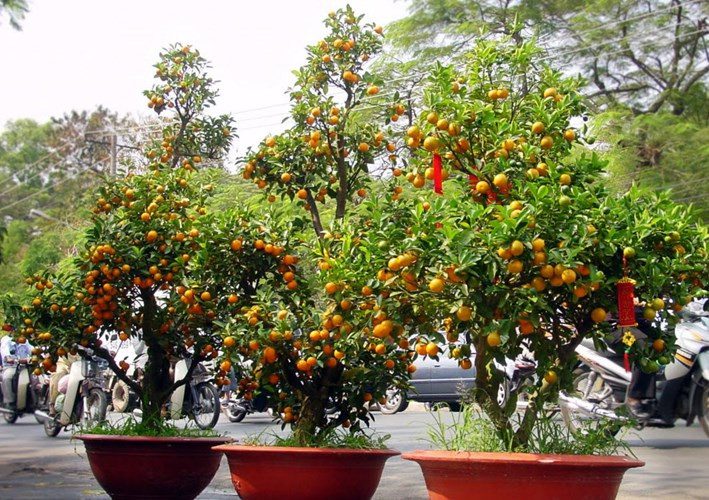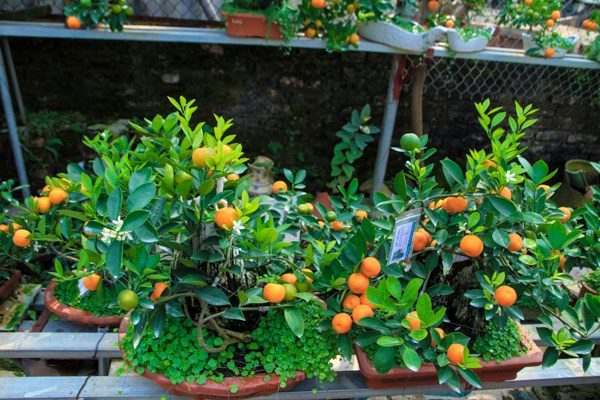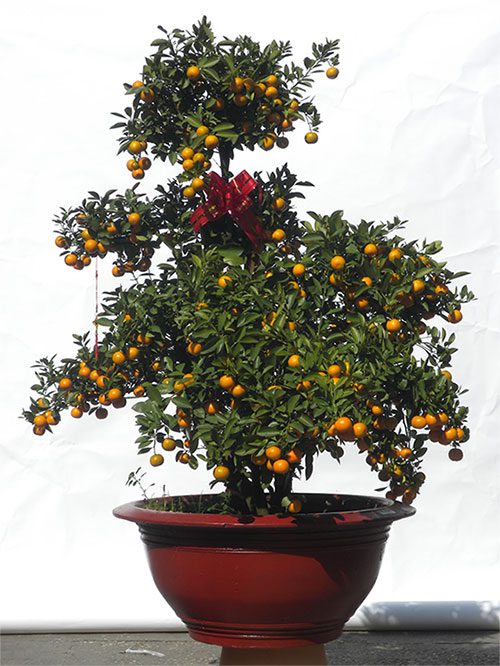The kumquat tree is a vibrant, fruit-bearing plant that is very familiar to the people of Vietnam, especially during the Tết holiday. The kumquat has many values in daily life; its fruit is rich in nutrients and serves as one of the herbal remedies in traditional Vietnamese medicine. In the Southern region, the kumquat is also referred to as tắc, while in the Southwestern region, it is known as hạnh.
Kumquat bonsai, scientifically named Citrus japonica, is a native species from East Asia. This tree is indispensable during Tết for the Vietnamese people. Kumquat bonsai symbolizes prosperity; the healthier the tree and the more abundant the fruit, the more wealth and fortune it brings.

Kumquat bonsai symbolizes prosperity.
The kumquat tree is relatively easy to cultivate, blooms throughout the year, and can be grown year-round. It grows quickly, branches out abundantly, has a diverse leaf canopy with short leaves and round tips, and the essential oils on the leaves emit a fragrance reminiscent of oranges and lemons.
Aside from its ornamental value, kumquat fruit is highly nutritious and is commonly used in traditional medicine to treat ailments caused by cold, such as sore throat, stomach cold, and flu. Additionally, kumquats are used to make jams or as a sour seasoning in various dishes.

A beautiful kumquat bonsai features large, lush leaves, shiny, uniform fruit, and plenty of new shoots.
A perfect kumquat bonsai must meet several criteria: the leaves should be large, dark green, and glossy; the kumquat fruit must be uniform, plump, and abundant with buds and new shoots.
Legend of the Kumquat Tree at Tết
According to legend, in a village long ago, there were three close friends. Quân loved martial arts, Mộc was interested in agriculture and nature, and Thư enjoyed poetry and music. Among them, Quân was the one with the hardest life, being deaf and mute since childhood, yet he had exceptional martial skills, earning him the nickname “Quất roi” (Kumquat Whip).

A beautiful kumquat tree during Tết.
A few years later, the country was invaded by enemies. Despite the nation’s united front against the external threat, the enemy was too strong to be easily defeated. During this time, Quất roi expressed his desire to fight against the enemy, asking his two friends to convey his intentions to the leaders.
After receiving permission to go to battle, Quất roi fought against the enemy for three consecutive days and emerged victorious. Upon his return, the king rewarded him with a rare plant and advised him: “If you seek wealth and prosperity, harvest the fruit; if you wish to ward off misfortune, plant the branches in the ground.” The following year, Quất roi’s village was covered in snow, with a bitter cold that left crops, animals, and even people suffering. Seeing this, Quất roi followed the sage’s advice and planted branches from the divine tree in various locations. Indeed, the weather cleared, and the cold faded, with trees and all living beings revived and thriving.
Since then, every spring, people have planted this type of tree in front of their homes, hoping for peace, wealth, and to commemorate Quất roi, which is why this plant is called Quất.
Significance of the Kumquat Tree During Tết
The kumquat tree is often chosen by people for decoration during Tết because, in Sino-Vietnamese pronunciation, the sound of the word “quất” is similar to the sound of “cát” in cát tường, which means good fortune and blessings.
The kumquat tree, with its lush green leaves and abundant yellow fruit, symbolizes prosperity, promising a fruitful year ahead, full of vitality and success.

Kumquats symbolize good fortune and bring luck.
Thus, every Tết, in addition to choosing auspicious days for cleaning and preparing homes, families arrange kumquat trees, hoping to bring joy and luck throughout the year.
Feng Shui experts believe that the kumquat bonsai displayed during Tết is one of the few plants that embodies the five elements. As everyone has different life paths, the kumquat tree achieves the balance of five elements: metal (white flowers) generates water (dark green leaves), water nourishes wood (the tree trunk), wood generates fire (ripe orange fruit), fire creates earth (the soil in the pot), and earth generates metal (white flowers). Therefore, displaying this type of bonsai brings good fortune to the homeowner throughout the year.
According to Feng Shui, trees laden with kumquats are embodiments of wealth. The more fruit they bear, the greater the wealth. The time when kumquats bloom is also when water nourishes wood, and wood embodies vitality. Ultimately, they all symbolize wealth and success in one’s career.
In addition, kumquat branches heavy with fruit symbolize health, peace, longevity, and good fortune in love, representing the unity of multiple generations within a family.


















































